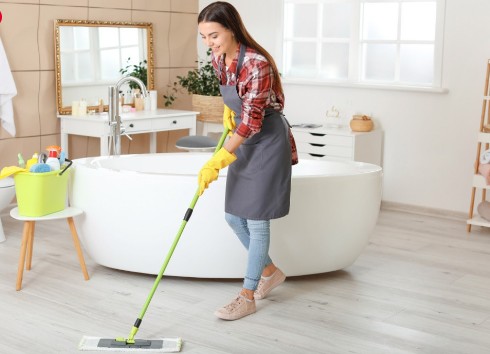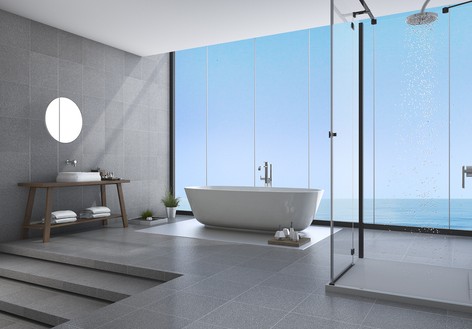So, you spend your precious time every week cleaning your bathroom, and when you think it will stay clean for some time, you find dust in different places after a few days. This leaves you with many questions, including: why is my bathroom so dusty?
Your bathroom is dusty, probably because of poor ventilation, high humidity, leaving windows open, or pets in the home. Other reasons are white surfaces, non-water resistance ceiling boards, and improper or infrequent cleaning.
Below is a detailed look at what causes a bathroom to be dusty, how to remove dust in bathrooms, and keep it from being dusty.

Why Is My Bathroom So Dusty? (8 Reasons)
Finding out what causes your bathroom to be dusty will help you develop a lasting solution to keep it clean and dust-free. So, before bringing out the cleaning supplies, below are what could be making your bathroom dusty.
1. Poor Ventilation
Dust particles can accumulate in your bathroom due to poor ventilation, as it can make the air in the room stagnant. Dust particles will settle on surfaces like countertops, floors, and fixtures if the air in your bathroom is not adequately circulated.
In addition to dust, poor ventilation can lead to moisture buildup, thus contributing to mold and mildew growth. These substances can exacerbate respiratory problems and cause unpleasant odors.
Essentially, proper ventilation helps to keep a healthy, comfortable bathroom. It helps remove excess moisture, pollutants, and odors, as well as circulate fresh air into the space.
2. High Humidity
High humidity in your bathroom provides a conducive environment for allergens like dust mites, thus increasing dust accumulation. These microscopic insects eat organic matter in dust, like cells of dead skin cells.
Dust mites do well in humid environments since they provide the moisture they require for survival. Since humid air makes dust particles heavier and stickier, they will easily settle on your bathroom surfaces and form a visible dust layer.
Additionally, mold and mildew grow in humid environments, contributing to dust accumulation and other particles.
Fortunately, you can keep the humidity levels in your bathroom in check by ventilating the space using an exhaust fan or opening a window during and after showering or bathing. Also, consider absorbing excess moisture with a dehumidifier.
Furthermore, regularly cleaning surfaces can also help reduce particle accumulation in your bathroom.
3. Leaving Windows Open
While leaving your bathroom windows open lets in the fresh air and helps lower humidity, the downside is that it allows dust and other particles from outside to enter the room. This is especially true if you live in an area with high dust levels, such as near a construction site, a busy road, or in a desert climate.
Aside from dust particles from outside, leaving windows open also make air currents carry dust particles from other areas of your home into the bathroom, making it dusty. Furthermore, open windows allow moisture into your bathroom, contributing to mold and mildew growth, further exacerbating the dust accumulation problem.
In that case, consider keeping your bathroom windows closed, mainly when used. Also, use proper ventilation methods, such as an exhaust fan, to remove excess moisture and airborne particles.
Furthermore, consider opening other windows to let in fresh air or a window screen to filter out dust and other pollutants.

4. Dusty Vents and Leaky Ductwork
A central HVAC system heats your bathroom through vents, filters, and ducts network. The vents in your bathrooms are typically installed in the ceiling or wall and connected to a duct leading to the building’s exterior.
On the other hand, bathroom ductwork typically runs from the exhaust fan to the building’s exterior. It is often made with various materials, including metal, flexible plastic, or rigid foam.
Bathroom vents and ductwork help provide ventilation and remove odors and too much moisture. However, these parts must stay in good condition to function optimally, so maintenance is critical.
Leaky ductwork and dusty vents contribute to dust buildup in your bathroom. They allow airborne particles to circulate throughout your home’s HVAC system and settle on the bathroom surfaces.
For instance, leaky ductwork can cause dust and other pollutants to enter your home’s HVAC system from places. These include the attic, crawl space, or garage, and then distribute these particles throughout your home, which can then settle in your bathroom.
Similarly, dusty vents can release dust and other airborne particles into your bathroom when the HVAC system is running. This can occur when air passes through dusty vents, causing dust to become airborne and settle on various surfaces.
5. Non-Water-Resistant Ceiling Boards
Non-water-resistant ceiling boards are less durable, susceptible to moisture damage and mold and mildew growth, and difficult to clean, especially when damaged or stained. When these ceiling boards absorb moisture, they warp, crack, or deteriorate, making them unsightly.
In addition, they create spaces where dust can accumulate and settle, contributing to dust buildup in your bathroom. Cleaning damaged ceiling board spaces can be challenging, thus further allowing dust accumulation.
Additionally, excessively damaged non-water resistant ceiling boards may even begin to release dust particles, contributing to the overall dust quantity in your bathroom. Fortunately, you can avoid this by choosing ceiling materials designed explicitly for high-moisture environments.
Therefore, install water-resistant ceiling boards made from materials like PVC or fiberglass. They are less prone to humidity and moisture damage and can be easier to clean and maintain.
However, if your bathroom has non-water-resistant ceiling boards, regularly inspect them for signs of damage signs then repair or replace them. Additionally, regularly clean and dust the surfaces in your bathroom to prevent particle buildup, even in hard-to-reach areas like the ceiling.
6. White Surfaces
White surfaces show dust and other particles more easily than darker surfaces, making them appear dustier. This can be particularly noticeable on white bathroom fixtures and surfaces, such as the sink, toilet, and bathtub.
In addition, poorly maintained and uncleaned white surfaces can accumulate dust and other particles, creating a dust layer that is more noticeable on a white surface than on a darker one.
7. Pets
Pets can contribute to dust accumulation in your bathroom since they shed hair and dander, which can become airborne and settle on surfaces throughout your home, including your bathroom. In addition, pets can track dirt and other debris into the bathroom from outside.
This can contribute to dust buildup on floors, countertops, sink basins, and other surfaces.
Regularly cleaning your home, including the bathrooms, helps remove pet hair and other debris. In addition, consider establishing pet-free zones in your home, including your bathroom.
This will help minimize pet hair and dander introduced into the space, reducing particle accumulation over time.
8. Infrequent or Irregular Cleaning
Having a dusty bathroom can simply be caused by not cleaning it regularly. Also, you may be using the wrong bathroom cleaner, thus leaving the surfaces sticky hence attracting dust accumulation.

How To Get Rid Of Dust In Bathroom
Now that you know what’s making your bathroom dusty, let’s work on removing it and keeping it clean and dust-free.
a) Dust All Surfaces
Start by removing all the items in your bathroom countertops, shower, or bathtub to make your work easier and ensure you reach every surface. Then wipe down every bathroom surface, including countertops, shelves, and fixtures, not forgetting corners and hard-to-reach areas, using a microfiber or damp cloth.
b) Clean and Repair Your Vents
Since bathroom vents accumulate dust, cleaning and maintaining them helps keep your bathroom from being dusty. However, before doing so, switch off power to the vents, then take out the vent cover from the wall or ceiling with a screwdriver.
Soak the vent cover in mild detergent and warm water for a couple of minutes, then brush dirt and debris using a soft brush or cloth. After that, clean the vent interior with a vacuum cleaner or brush.
Furthermore, replace air filters and check and repair any leaks or damage to your ductwork. Having clean and working fans and vents is essential because bugs can get in through bathroom fans and also help prevent dust accumulation.
c) Clean Your Bathroom Floors
Sweep or vacuum your bathroom floors to remove loose dirt or debris, then apply water and mild detergent solution on the floors using a mop or sponge. Scrub the floors, especially the stained parts, with a scrub brush or sponge, then rinse with clean water.
After that, dry your bathroom floors with a clean towel or mop, then disinfect them if necessary. Furthermore, keep all the floors in your home clean and dust free to avoid transferring them to your bathroom.
d) Clean Your Shower Curtain
Your shower curtain can also accumulate dust, so wash your fabric shower curtain in your washing machine with a mild detergent or by hand. On the other hand, if you have a plastic shower curtain, wipe it down with a damp cloth.
e) Clean Your Bathroom Accessories
Wipe down your bathroom accessories, such as soap dishes or toothbrush holders, with a damp cloth because dust can accumulate in them. Also, do not forget your bathroom closets if you have any.
f) Wash Your Towels
Remove the dust or debris on your bath towels and hand towels by washing them with water and mild detergent.
g) Consider An Air Purifier
Consider using an air purifier to filter out any airborne particles if you have persistent dust issues in your bathroom.
h) Keep Pets Out of Your Bathroom
If you let your pets go in and out of your bathroom freely, they will leave their dander and hair inside. Furthermore, they can track dust and other particles from outside or other parts of your home into your bathroom.
i) Change Your Bathroom Decor
Opt for décor materials that are easy to clean and dust, like vinyl or tile flooring. Moreover, avoid decorative materials such as fabric curtains or rugs.
Concluding Remarks On Why Is My Bathroom So Dusty?
Once you figure out why your bathroom is dusty, as discussed in this post, you can comfortably fix the problem with a few strategies. You should be able to keep the dust under control through regular cleaning and a couple of adjustments, like knowing when to leave the windows open or closed.
